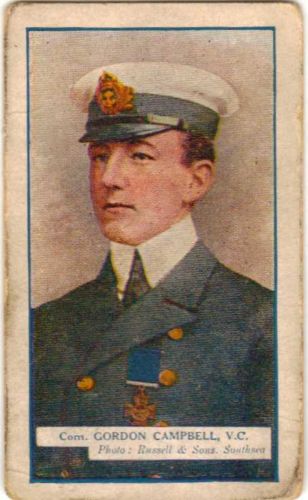Vice
Admiral Gordon Campbell VC DSO (2 bars)
(also awarded the Croix de Guerre and appointed a chevalier of the Légion
d'honneur)
Royal Navy
Born in Croydon on 6th January 1886
Died in Isleworth 3 July 1953
Buried at All Saints Churchyard, Crondall
Elected M.P.for Burnley in 1931
Born on 6 July 1886, he was educated at Dulwich College, which he attended between 1898 and 1900. He then joined the Royal Navy. In 1917, by the age of 31, he had reached the rank of Commander during First World War when the act for which he was awarded the VC took place. On 17 February 1917 in the north Atlantic, Commander Campbell, commanding HMS Farnborough (Q.5) (one of the "mystery" Q ships) sighted a torpedo track. He altered course and allowed the torpedo to hit Q.5 aft by the engine-room bulkhead. The 'Panic party' got away convincingly, followed by the U-boat. When the submarine had fully surfaced and was within 100 yards of Q.5—badly damaged and now lying very low in the water—the commander gave the order to fire. Almost all of the 45 shells fired hit the U-boat which sank. Q.5 was taken in tow just in time and was safely beached. On 22 March 1916, another U-boat, SM U-68 was sunk by Farnborough.
Campbell also commanded HMS Dunraven during the action of 8 August 1917 when she was sunk by SM UC-71.[2] Victoria Crosses were awarded to two crewmen who were selected by ballot from amongst the crew of Dunraven, Lieutenant Charles George Bonner and Petty Officer Ernest Herbert Pitcher.
Later life
Campbell later achieved the rank of Vice Admiral. He commanded the battlecruiser
HMS Tiger 1925-27 and served as Naval Aide-de-Camp to George V 1928-29.
In 1931, he was elected as National Member of Parliament for Burnley,
defeating the Labour leader, Arthur Henderson. In 1935, however, standing
as a National Liberal, he lost his seat.
Campbell wrote several publications, including the successful My Mystery Ships. His brother, Sir Edward Campbell, was also a Member of Parliament.
His Victoria Cross is held at his old school, Dulwich College.
